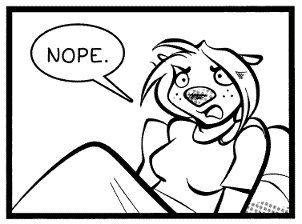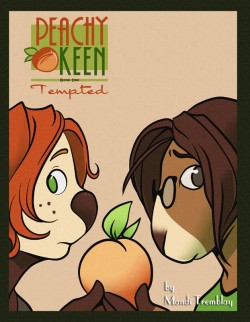Review: 'Peachy Keen Book 1: Tempted', by Mandi Tremblay
It's not easy to admit feelings for a long-time friend; but for the classmates in Mitti's debut graphic novel, their first admission must be to themselves.
It is 1955 and best friends Clover and Logainne are looking forward to graduating from Lincoln High School and getting on with their lives. However when Clover fumbles for an excuse to avoid going to the senior prom with someone, she blurts out Logainne's name as her intended date. Now the whole school thinks there is more to their friendship than meets the eye, putting both their reputations and Logainne's honors student status at risk. As they scramble to contain the damage, at least one of them begins to wonder where her heart truly lies. (back cover)
Sofawolf Press, January 2012, trade paperback $14.95 (131 + 6 pages, B&W interior)
This graphic novel raised $4,127 with a Kickstarter project, and was promoted at Further Confusion 2012. Its introductory chapter is available on Fur Affinity and deviantART. In subsequent chapters, we find that a cat scorned is a dangerous thing; Clover finds help from an unexpected source;1 and Logainne is shown to be not quite as innocent as she first appears.
Overall, the art is expressive and appealing, with clean line-work and dynamic poses. Shading is primarily rendered with digital screentone. Each character is distinctive, too – though when first looking at Clover, I couldn't help but think of Oshawott. Perhaps I've just spent too much time around Pokémorphs. The resemblance fades in later chapters, as her face is depicted with fewer and stronger lines, and becomes less rounded. Likewise, Logainne's face becomes less oval-shaped, with pronounced cheekbones.
The protagonists are hindered by Cyndi, a stereotypically immature "daddy's girl" with a malicious streak, and aided by the leather-clad Toby, a red-tailed hawk. The girls grew up with Toby, and their casual deflection of his preening is second nature. Still, despite his Grease-like demeanor, Toby is no featherhead, and often has good advice for his friends. (He also provides a moment of genuine mirth during the prom.)
It's not clear what was gained by making the characters anthropomorphic animals, beyond playing off common species personality stereotypes. There is no evidence that Toby can fly, or that Clover is especially good at swimming. Sure, she paddles in a river, but that fits her tomboy motif. Her brother Billy is also a sea otter; while there appears to be no taboo against mixed-species relationships, we don't see any progeny.
Today, homosexuality is decidedly out of the closet, but in the mid-1950s it was still "the love that dare not speak its name". Indeed, the "l-word" is uttered not once in this novel, but we hear others — "criminal deviant", "mentally ill". As lesbian pulp fiction celebrity Ann Bannon explains:
You were sick, you were wrong, you were a corrupting influence. [...] anywhere there was failure and decay, the cause was gay people. Your church would excommunicate you. Your family would disown you. Your employer would fire you. A person risked everything just by coming out.
This understanding is echoed by Logainne, as the enormity of their situation is revealed (p. 107):
What are we going to do? We're SICK, right?
That's what everyone says... People like us aren't well.
People will find out. They'll put us away...
Yet despite this, it all had the aura of a high-school drama. I never felt the pair were in danger. Indeed, Clover receives outright encouragement from a source who should arguably know better.
Perhaps peril is too much to expect in a tale of teenage romance. The book ends on a high note, but with storm-clouds gathering on the horizon. A sequel is planned, but it'll be 2013 before the pair finds their way to a happy ending – if they ever do. Don't feel you have to wait, though.
This perfect-bound publication meets Sofawolf's established standards; the work appears free of misprints (though I saw a misspelling on p. 96). Alternate renderings of the lead characters are provided at the start of each chapter by Sigil, Technicolor Pie, Portzebie and Savannah Horrocks.
1 A historical footnote: Daughters of Bilitis were formed in October 1955; it was only in October 1956 that its newsletter, The Ladder, gained national distribution. For the first year, it had a drawing of lesbians climbing a ladder into the clouds on the cover, hence the name.

About the author
GreenReaper (Laurence Parry) — read stories — contact (login required)a developer, editor and Kai Norn from London, United Kingdom, interested in wikis and computers
Small fuzzy creature who likes cheese & carrots. Founder of WikiFur, lead admin of Inkbunny, and Editor-in-Chief of Flayrah.

Comments
Post new comment